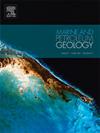Pyrite morphologies in Bazhenov Formation source rocks: diversity, systematic classification, sulfur isotopic composition and insights into sedimentation and diagenesis processes
IF 3.6
2区 地球科学
Q1 GEOSCIENCES, MULTIDISCIPLINARY
引用次数: 0
Abstract
Pyrite is a common authigenic mineral in organic-rich source rocks, which is diverse in morphology and carries valuable genetic information about geological processes. This study proposes comprehensive genetic morphological classification of pyrite aggregates in organic-rich shales of the Bazhenov Formation – one of the world largest source rock located in the Western Siberia. Scanning electron microscopy was used to analyze over 530 samples from 17 wells, identifying various types of pyrite such as framboids (with corresponding subtypes based on orderliness of the internal structure, crystallographic shape of microcrystals, infilling of internal structure, and integrity), euhedral crystals, and pyrite pseudomorphosis. The obtained sulfur isotopic composition for framboidal pyrite, which turned out to be the lightest (δ34S vary in the range from −55.38 ‰ to −26.02 ‰), is indicative of anoxic conditions on seafloor. Euhedral pyrite develops in diagenesis under limited sulfate supply, reflecting slow growth in pore-water depleted in 32S (δ34S values range from +15.05 ‰ to +26.49 ‰). Described morphological types cover the diversity of pyrite forms in other similar geological objects around the world, which allows pyrite to be used as a geochemical proxy for paleoenvironmental reconstructions and hydrocarbon exploration, enhancing understanding of sulfur cycle and basin evolution.
巴治诺夫组烃源岩黄铁矿形态:多样性、系统分类、硫同位素组成及沉积成岩作用
黄铁矿是富有机质烃源岩中常见的自生矿物,其形态多样,具有重要的地质成因信息。本文提出了世界上最大的烃源岩之一、位于西伯利亚西部的巴济诺夫组富有机质页岩中黄铁矿聚集体的综合成因形态分类。利用扫描电镜对17口井的530余份样品进行了分析,鉴定出了草莓状(根据内部结构的有序性、微晶的晶体形态、内部结构的充填性、完整性等特征对应的亚型)、自形晶体和黄铁矿假形态等多种黄铁矿类型。树状黄铁矿的硫同位素组成最轻(δ34S变化范围为−55.38‰~−26.02‰),反映了海底缺氧条件。自形黄铁矿在硫酸盐供应有限的条件下发育,反映了32S枯竭孔隙水生长缓慢(δ34S值范围为+15.05‰~ +26.49‰)。所描述的形态类型涵盖了世界上其他类似地质对象中黄铁矿形态的多样性,这使得黄铁矿可以作为古环境重建和油气勘探的地球化学指标,增强了对硫循环和盆地演化的认识。
本文章由计算机程序翻译,如有差异,请以英文原文为准。
求助全文
约1分钟内获得全文
求助全文
来源期刊

Marine and Petroleum Geology
地学-地球科学综合
CiteScore
8.80
自引率
14.30%
发文量
475
审稿时长
63 days
期刊介绍:
Marine and Petroleum Geology is the pre-eminent international forum for the exchange of multidisciplinary concepts, interpretations and techniques for all concerned with marine and petroleum geology in industry, government and academia. Rapid bimonthly publication allows early communications of papers or short communications to the geoscience community.
Marine and Petroleum Geology is essential reading for geologists, geophysicists and explorationists in industry, government and academia working in the following areas: marine geology; basin analysis and evaluation; organic geochemistry; reserve/resource estimation; seismic stratigraphy; thermal models of basic evolution; sedimentary geology; continental margins; geophysical interpretation; structural geology/tectonics; formation evaluation techniques; well logging.
 求助内容:
求助内容: 应助结果提醒方式:
应助结果提醒方式:


